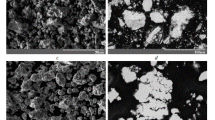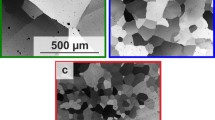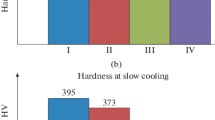The phase composition, type II microstresses, and coherent scattering domains (CSDs) of multicomponent (medium- and high-entropy) bcc solid solutions with an average electron concentration, Csd, ranging from 4.6 to 5.47 e/a were studied. The effect of these characteristics on the hardness and Young’s modulus was analyzed. The alloys were melted in a MIFI-9 vacuum arc furnace using components with a purity of at least 99.5 wt.%; the ingots were remelted six times. The hardness and Young’s modulus of the alloys were determined from nanoindentation curves plotted with a Micron Gamma unit under a load from 0.98 to 2.94 N using a Berkovich diamond pyramid under automated loading and unloading. A relatively small change in the quantitative chemical composition of the samples led to a noticeable change in the lattice parameter, type II microstresses, CSDs, microhardness, and Young’s modulus. The greatest possible type II microstresses and minimum CSD sizes were observed for the alloys characterized by high average mismatch between the atomic sizes of their constituent elements. Increase in the electron concentration in the alloys led to higher hardness and Young’s modulus and lower lattice parameter. Increase in the type II microstresses was also accompanied by higher hardness and Young’s modulus. The microhardness H of alloys significantly exceeded that calculated with the mixture rule, Hmix, and was determined by solid-solution hardening (∆H = H – Hmix ranging between 2.9 and 6.4 GPa). Type II microstresses precisely calculated from the X-ray line width can be used for measuring the distortion of the solidsolution lattice and assessing solid-solution hardening. The relationship between the magnitude of solid-solution hardening, Young’s modulus, and lattice microdistortions (type II microstresses) was proposed.



Similar content being viewed by others
References
S. Ranganathan, “Alloyed pleasures: multimetallic cocktails,” Curr. Sci., 85, No. 5, 1404–1406 (2003).
J.W. Yeh, S.K. Chen, S.J. Lin, J.Y. Gan, T.S. Chin, T.T. Shun, C.H. Tsau, and S.Y. Chang, “Nanostructured high-entropy alloys with multiple principal elements: novel alloy design concepts and outcomes,” Adv. Eng. Mater., 6, Issue 1–2, 299–303 (2004).
A.A. Rusakov, X-Ray Radiography of Metals [in Russian], Atomizdat, Moscow (1977), p. 480.
Norihiko L. Okamoto, K. Yuge, K. Tanaka, H. Inui, and Easo P. George, “Atomic displacement in the CrMnFeCoNi high-entropy alloy—A scaling factor to predict solid solution strengthening,” AIP Adv., 6, No. 12, 125008-1–125008-8 (2016).
O.V. Sobol’ and O.A. Shovkoplyas, “On advantages of X-ray schemes with orthogonal diffraction vectors for studying the structural state of ion-plasma coatings,” Tech. Phys. Lett., 39, No. 6, 536–539 (2013).
I.C. Noyanand and J.B. Cohen, Residual Stress Measurement by Diffraction and Interpretation, Springer-Verlag, New York (1987), p. 350.
Web resource: http://www.icdd.com.
Web resource: http://www.softforfree.com/programs/new_profile-28231.html.
G.V. Davydov, N.A. Erokhov, and G.F. Belyaeva, “Contribution to the method for approximation of X-ray diffraction line profile,” Experientia, 23, 352 (1967), https://doi.org/10.1007/BF02144510.
E. Aznakayev, “Micron-gamma for estimation the physico-mechanical properties of micro-materials,” Proc. Int. Conf. Small Talk – 2003, San Diego, California, USA (2003), TP.001, pp. 8–12.
ISO 14577:1-2015. Metallic Materials—Instrumented Indentation Test for Hardness and Materials Parameters. Part 1: Test Method, 77.040.10, p. 54.
V.F. Gorban, N.A. Krapivka, and S.A. Firstov, “High-entropy alloys–electron concentration–phase composition–lattice parameter–properties,” Fiz. Met. Metalloved., 118, No. 8, 1–13 (2017).
O.N. Senkov, J.M. Scott, S.V. Sencova, et al., “Microstructure and room properties of a high-entropy TaNbHfZrTi alloy,” J. Alloys Compd., 509, 6043–6048 (2011).
Web resource: www. web elements.com.
S.A. Firstov, T.G. Rogul, N.A. Krapivka, et al., “Solid-solution hardening of high-entropy AlTiVCrNbMo alloy,” Deform. Razrush. Mater., No. 2, 9–16 (2013).
V.F. Gorban and E.P. Pechkovski, “Instrumented indentation for determining the structural state of materials,” Powder Metall. Met. Ceram., 49, No. 7–8, 424–429 (2010).
L.R. Owen and N.G. Jonesaet, “Lattice distortions in high-entropy alloys,” J. Mater. Res., 33, No. 19, 2954–2969 (2018).
J.W. Yeh, S.K. Chen, J.Y. Gan, S.J. Lin, T.S. Chin, T.T. Shun, C.H. Tsau, and S.Y. Chang, “Formation of simple crystal structures in Cu–Co–Ni–Cr–Al–Fe–Ti–V alloys with multiprincipal metallic elements,” Metall. Mater. Trans. A, 35, 2533–2536 (2004).
O.B. Perevalova, A.V. Panin, and E.O. Tyurin, “Change of microdistortions and total root-mean-square atom displacements in the α phase of ferritic/martensitic steel,” Faz. Perekh. Uporyad. Sost. Nov. Mater., No. 1, 28–32 (2013).
Acknowledgements
The authors are grateful to the STCU fund for financial support of the research effort under Project 6360 “New High-Temperature Materials Based on the Multicomponent (High Entropy) Alloys with Controlled Nanoclustered Structure”.
Author information
Authors and Affiliations
Corresponding author
Additional information
Translated from Poroshkova Metallurgiya, Vol. 59, Nos. 11–12 (536), pp. 127–135, 2020.
Rights and permissions
About this article
Cite this article
Sobol, O., Gorban, V., Krapivka, N. et al. Microdistortions, Hardness, and Young’s Modulus of Multicomponent Bcc Solid Solutions. Powder Metall Met Ceram 59, 715–721 (2021). https://doi.org/10.1007/s11106-021-00206-4
Received:
Published:
Issue Date:
DOI: https://doi.org/10.1007/s11106-021-00206-4




